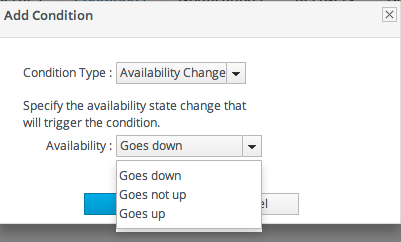18.4. Detailed Discussion: "Not Up" Alert Conditions
There are four possible availability states for a resource:
- Up
- Down
- Unknown
- Disabled
These are summarized in Section 18.1.3, “Availability States”.
Since one of the core monitoring factors for a resource is knowing its availability, alerts can be defined on any availability state change.
Generally, the condition can be set to send an alert on any explicit state. For example, a goes down condition alerts only when the availability state changes to DOWN. Any other state change is ignored.
Figure 18.7. Availability Change Conditions
For critical platforms or resources, however, any change in availability other than UP may need to trigger an alert. Even known state changes like DISABLED.
The goes not up condition triggers an alert if there is a change to any availability state other than UP, so it is a logical OR combination of DOWN, UNKNOWN, and DISABLED conditions.
Note
Availability change conditions are well suited to using recovery alerts. When a resource goes down (or not up) an alert can fire that informs the administrators and then enables (or recovers) a companion alert that will inform them when the resource is available again.
See Section 25.2.5, “Detailed Discussion: Automatically Disabling and Recovering Alerts” for more information.
